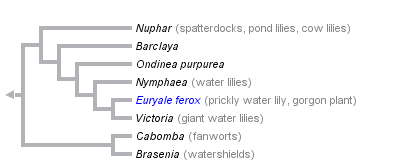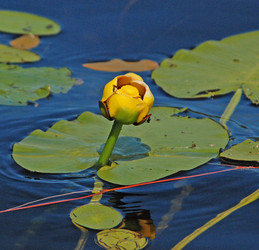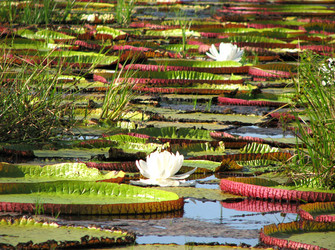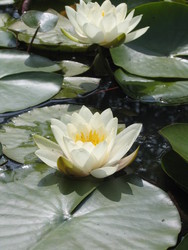Nymphaeaceae
Water lilies and their relatives



This tree diagram shows the relationships between several groups of organisms.
The root of the current tree connects the organisms featured in this tree to their containing group and the rest of the Tree of Life. The basal branching point in the tree represents the ancestor of the other groups in the tree. This ancestor diversified over time into several descendent subgroups, which are represented as internal nodes and terminal taxa to the right.

You can click on the root to travel down the Tree of Life all the way to the root of all Life, and you can click on the names of descendent subgroups to travel up the Tree of Life all the way to individual species.
For more information on ToL tree formatting, please see Interpreting the Tree or Classification. To learn more about phylogenetic trees, please visit our Phylogenetic Biology pages.
close boxReferences
Friis, E. M., K. R. Pedersen, and P. R. Crane. 2001. Fossil evidence of water lilies (Nymphaeales) in the Early Cretaceous. Nature 410:357-360.
Gandolfo, M. A., K. C. Nixon, and W. L. Crepet. 2004. Cretaceous flowers of Nymphaeaceae and implications for complex insect entrapment pollination mechanisms in early Angiosperms. Proceedings of the National Academy of Sciences (USA) 101(21):8056-8060.
Ito, M. 1987. Phylogenetic systematics of the Nymphaeales. Botanical Magazine (Tokyo) 100:17-35.
Les, D., D. K. Garvin and C. F. Wimpee. 1991. Molecular evolutionary history of ancient aquatic angiosperms. Proceedings of the National Academy of Sciences (USA) 88:10119-10123.
Les, D. H., E. L. Schneider, D. J. Padgett, P. S. Soltis, D. E. Soltis, and M. Zanis. 1999. Phylogeny, classification and floral evolution of water lilies (Nymphaeaceae; Nymphaeales): A synthesis of non-molecular, rbcL, matK, and rDNA data. Systematic Botany 24:28-46.
Löhne, C., T. Borsch, and J. H. Wiersema. 2007. Phylogenetic analysis of Nymphaeales using fast-evolving and noncoding chloroplast markers. Botanical Journal of the Linnean Society 154(2):141–163.
Moseley, M. F. Jr, E. L. Schneider, and P. S. Williamson. 1993. Phylogenetic interpretations from selected floral vasculature characters in the Nymphaeaceae sensu lato. Aquatic Botany 44:325–342.
Qiu, Y. L., J. H. Lee, F. Bernasconi-Quadroni, D. E. Soltis, P. S. Soltis, M. Zanis, E. A. Zimmer, Z. D. Chen, V. Savolainen, and M. W. Chase. 2000. Phylogeny of basal angiosperms: Analyses of five genes from three genomes. International Journal of Plant Sciences 161:S3-S27.
Schneider, E. L., S. Carlquist, K. Beamer, and A. Kohn. 1995. Vessels in Nymphaeaceae: Nuphar, Nymphaea, and Ondinea. International Journal of Plant Sciences 156:857-862.
Yamada, T., R. Imaichi, and M. Kato. 2001. Developmental morphology of ovules and seeds of Nymphaeales. American Journal of Botany 88:963-974.
Information on the Internet
- Center for Aquatic and Invasive Plants. University of Florida
- International Waterlily and Water Gardening Society
- Aquatic Gardeners Association
- Victoria Adventure Home. Water gardening.
Title Illustrations

| Scientific Name | Nuphar variegatum |
|---|---|
| Location | Seney NWR, Michigan, USA |
| Specimen Condition | Live Specimen |
| Source | DSZ_02161a |
| Source Collection | Flickr |
| Image Use |
 This media file is licensed under the Creative Commons Attribution-NonCommercial-ShareAlike License - Version 2.0. This media file is licensed under the Creative Commons Attribution-NonCommercial-ShareAlike License - Version 2.0.
|
| Copyright | © 2008 Jerry Oldenettel |
| Scientific Name | Victoria amazonica |
|---|---|
| Location | Buffalo Pond, near Karanambo ranch, on the Rupununi River. North Rupununi, Guyana |
| Specimen Condition | Live Specimen |
| Source | victoria amazonica at buffalo pond 2 |
| Source Collection | Flickr |
| Image Use |
 This media file is licensed under the Creative Commons Attribution-NonCommercial-ShareAlike License - Version 2.0. This media file is licensed under the Creative Commons Attribution-NonCommercial-ShareAlike License - Version 2.0.
|
| Copyright | © 2008 Nicholas Laughlin |
| Scientific Name | Nymphaea candida |
|---|---|
| Location | cultivated, Botanical Garden, Ghent |
| Specimen Condition | Live Specimen |
| Source | 2007-06-13 099 Nymphaea candida |
| Source Collection | Flickr |
| Image Use |
 This media file is licensed under the Creative Commons Attribution-NonCommercial License - Version 2.0. This media file is licensed under the Creative Commons Attribution-NonCommercial License - Version 2.0.
|
| Copyright | © 2007 Du-Sa-Ni-Ma |
About This Page
Page copyright © 2002
All Rights Reserved.
Citing this page:
Tree of Life Web Project. 2002. Nymphaeaceae. Water lilies and their relatives. Version 01 January 2002 (temporary). http://tolweb.org/Nymphaeaceae/20651/2002.01.01 in The Tree of Life Web Project, http://tolweb.org/











 Go to quick links
Go to quick search
Go to navigation for this section of the ToL site
Go to detailed links for the ToL site
Go to quick links
Go to quick search
Go to navigation for this section of the ToL site
Go to detailed links for the ToL site